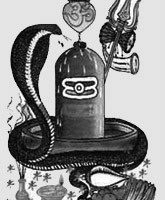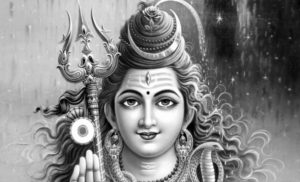In the Indian tradition, the deities Shiva, Rama, and Krishna have been revered by the learned and the lay for millennia. While Rama and Krishna were historical figures, Shiva is a mythological ideal. Whether one is a believer or a non-believer in the Supreme, one will greatly benefit from realizing the values that these three greats embody. Such is the conception of Shiva-Rama-Krishna.
While we speak about these deities, one shouldn’t think that it is a male chauvinistic approach, because these deities are always seen as inseparable from their consorts, their shaktis. We cannot think of Shiva without thinking of Parvati. Where there is Rama, there is Sita. And when we think of the colourful personality of Krishna, we instantly remember Radha, Rukmini, Satyabhama, and others. In fact, our tradition has so greatly valued the goddesses that their husbands are known by their names – Shiva is called Gaurishankara, Rama is called Sitarama, and Krishna is called Radhakrishna.
This tattva-traya—the ‘three divine essences’—represent the ideals at three different levels. Shiva represents the highest in an individual. Rama gives us a wonderful model for family life. Krishna is the symbol of how to live in society. Thus, these great heroes become our role-models in three different spheres of our life. Indeed there is Rama in Krishna and Krishna in Shiva and Shiva in Rama, just as there are aspects of our life that are both personal and societal. But we are considering the dominant traits in these deities and identifying them as ideals for a particular realm of being.
There are several texts and treatises composed about these deities but only a few have been able to capture their characteristic traits. Kalidasa’s Kumārasambhavam gives us a holistic picture of Shiva, Valmiki’s Rāmāyaṇa gives us a complete vision of Rama, and Vyasa’s Mahābhārata gives us the most authentic story of Krishna.
Shiva
In the end, we are our only refuge. We are born alone, we die alone. We have to uplift ourselves. Before changing the world, we have to change ourselves. That is the Shiva ideal. Shiva has transcended birth and death; he is an embodiment of dhyāna as well as nartana. He is contemplative and joyful. He meditates and he dances. What a contrast!
We find a reference to Shiva in the Veda itself. The Rudra of the Ṛgveda is none other than the Shiva of the Yajurveda. He is said to have a brilliant form and a radiant face. He has the ability to heal. He can give health and he can take it away. He is all-knowing, all-wise. He is the great god, Mahadeva. He resides in the Himalayas.
There has been much commotion and mistaken notions about the worship of the liṅga. Shiva is said to be a liṅga-svarūpī, i.e., manifest in the liṅga form. The word ‘liṅga’ comes from the root word ली श्लेषणे (to stick to, to adhere
to). The word लीयते means ‘to dissolve’ or ‘to become one with,’ which is why we have लीयते इति लिङ्गम् and लयनाल्लिङ्गम्. Basically liṅga is used as a symbol for what cannot be directly represented. The spirit of Brahman cannot be expressed in words, so we have an indication and that is liṅga. At the level of matter (adhibhūta) it is a symbol of creation, at the level of faith (adhidaiva) it represents Lord Shiva, and at the level of the Self (adhyātma) it represents the spirit of creation and dissolution.
Let us now consider the name Śiva. शिव means ‘auspicious.’ He is a deity of happiness. But he is also a fiery god. On the one hand, he has benign names such as Shiva, Shambhu, and Mayaskara that emanate peace and on the other hand, he has terrifying names like Ugra, Rudra, and Bhima that evoke fear. But Shiva transcends both the auspicious and the destructive. He has gone beyond names and traits. And if we look within ourselves, we find both these attributes—often contradictory—of gentleness and violence, of peace and agitation. These merely represent the diversity of our personality. The Shiva ideal shows us that we can resolve this dichotomy by going beyond the opposites.
Shiva has often been called ‘the destroyer’ but nothing can be further from the truth. He is a layakārī devatā – the deity who dissolves for the sake of renewal. It is not destruction but dissolution for the sake of new creation. When something dissolves, it merely becomes imperceptible; it is not destroyed. It takes a new form. Thus the cycle of creation is maintained. Shiva is a symbol of self-sufficiency. Once someone is fulfilled within, he doesn’t have to prove his worth to another. He doesn’t have to justify his actions to the world.
In the various Purāṇās and Āgamas, much has been written about Shiva. He is said to have multiple hues and various traits. But predominantly he is white in colour and of a peaceful disposition, for he remains undisturbed by the world.
If we look at Shiva’s physical form, we find a great deal of symbolism. Starting with the hair on his head – he is called ‘vyoma-keśa,’ suggesting that the sky itself is his hair. Śabda (sound, word) is connected with ākāśa (sky) and his matted locks represent Language. And in the case of Shiva, language itself is wisdom. Being a jñāna-svarūpī, whatever he utters becomes sacred. But jñāna that is static becomes stale and the Ganga flowing out of his head symbolizes the dynamism of his all-round learning. Shiva, the Gangadhara, is thus a symbol of wisdom.
Chandrashekhara is another name of his, for he has the crescent moon on his head. Typically the moon waxes and wanes but the moon on Shiva’s head is constant; it is eternally young. It is ever-growing but never becomes old. It is neither the new moon of ignorance nor the full moon of intellectual arrogance. After all, a lunar eclipse occurs only
during a full moon; we can get humbled only when we have pride. Similarly, a new moon can eclipse even the sun; ignorance can become dangerous for all. But the crescent moon on Shiva represents jñānopāsanā – the constant striving to learn more without becoming complacent. The moon is a symbol of sthiti, of calmness, of water. The moon is also a symbol of joy, for what is the use of jñāna that doesn’t lead to ānanda?
Come down a bit and we have the third eye on his forehead. This is a symbol of laya, of anger, of fire. Shiva is hailed as Trinetra and Virupaksha for this reason. How can we have coolness (of the moon) and heat (of the third eye) at one place? It might appear strange. But this happens with us too – one moment we are so calm and composed but the next moment we might lose our temper and turn into a different person altogether. We need both peace and wrath. Goodness doesn’t imply helplessness or weakness. We need strength and control, anger and gentleness. That’s perhaps the reason why both water (Āpa) and fire (Agni) have been said to represent wisdom in our tradition. Even in science, for instance, we have the hard sciences (like mathematics) and soft sciences (like psychology). The third-eye, also called jñāna-netra, is a symbol of awareness and insight. With two of his eyes, Shiva pervades Space and with his third eye, he pervades Time. Space is three-dimensional and Time is threefold (past, present, and future); these six aspects of space-time also seen in the six karakas (kartā, karman, karaṇa, sampradāna, apādāna, and adhikaraṇa) are wholly comprehended by Shiva. He is thus Visvesvara and Visvanatha, the lord of the universe.
Names like Vishakantha and Nilakantha have been given to Shiva because of the dark-coloured poison in his throat. It represents Shiva’s self-control. It is not that Shiva is alien to evil; he has swallowed it and gone beyond it. He is neither overly joyful about the crescent moon nor scared of poisonous snakes. He is after all, Nagabhushana, the one whose ornaments are snakes. Neither does he feel sanctified by the flowing Ganga on his head nor does he feel desecrated by the skull he uses as a begging bowl. He isn’t troubled to be besmeared with the ashes from funeral pyres; he doesn’t get carried away by Gauri’s intimate embrace. Forever balanced, he is completely at peace with all things – pleasant and unpleasant. A famous verse captures this in a memorable fashion:
भीतिर्नास्ति भुजङ्गपुङ्गवविषात्प्रीतिर्न चन्द्रामृता-
न्नाशौचं च कपालदामलुलनात्शौचं न गङ्गाजलात्।
नोद्वेगश्चितभस्मना न च सुखं गौरीस्तनालिङ्गना-
दात्मारामतया हिताहितसमः स्वस्थो हरः पातु वः॥
To be continued.
This serialized article has been translated by Hari Ravikumar from the author’s Kannada lecture series held at the Gokhale Institute of Public Affairs, Bangalore in 2009. Thanks to Shashi Kiran B N for his careful review and astute feedback.


















































